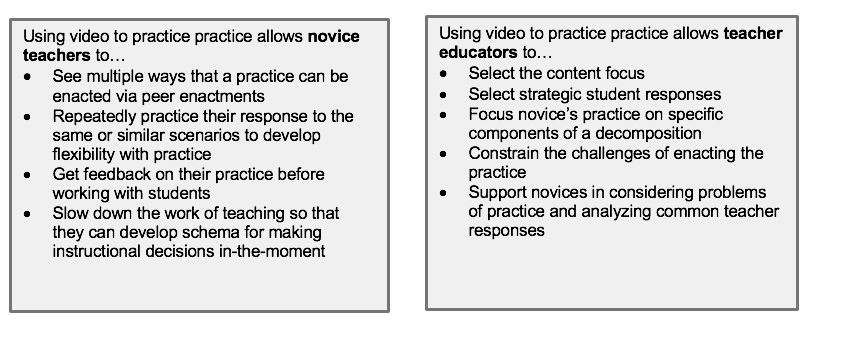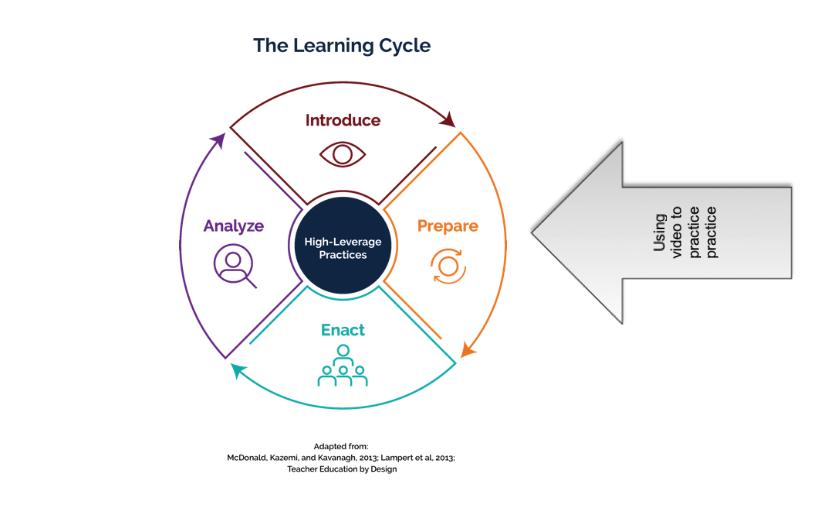- 1Why use video to practice practice?
- 2How can using video to practice practice advance justice in the classroom?
- 3What are some challenges and limitations of using this pedagogy?
- 4Which high-leverage practices should teacher educators pair with using video to practice practice?
- 5Where in the learning cycle can using video to practice practice be used?
- 6How do teacher educators plan to use video to practice practice?
Video allows novices to hone their skills in response to a common “text” of teaching. By “text” we mean that all novices are utilizing the same information – context, students, verbal and visual input – to prompt their practice. In this way, video can allow novices to see that a variety of techniques and ways of carrying those techniques out are possible and productive in a situation. These shared experiences can establish that teaching cannot be scripted, but that moves can be used in more or less productive ways.
The shared text of video also allows teacher educators to control the subject matter content that novices are responding to, ensuring that novices work on high-leverage content and practice. Additionally, teacher educators can use video to enable novice teachers to try out teaching practices and receive feedback from the teacher educator.

Teacher educators can use video go give novices multiple opportunities to try out the work of teaching, with feedback. Because teachers make hundreds of in-the-moment decisions while teaching a lesson, there are hundreds of places where inequities could occur (Ball, 2017). Video-based practice allows teacher educators to teach novices specific moves they can use and develop facility with those moves so that novices develop automaticity with more equitable teaching moves.
Activities that use video to practice practice can build novices’ skills of noticing and responding to racialized patterns in classrooms. For example, a teacher educator may choose a video where a student of color has given what appears to be an incorrect answer during a whole class discussion. The teacher educator might ask novices to make the next teaching move to practice moves to identify and make use of strengths in a student’s reasoning.
Curating a set of videos that focuses on important content while also allowing novices to practice can be challenging. There are increasing numbers of resources available, including the Teaching & Learning Exploratory, where TeachingWorks has begun to gather a set of resources aligned to high-leverage practices. However, it can still be challenging work to identify a set for use in your own context.
The use of video to practice practice requires careful design to focus novices on specific moves they can make.
Without careful work on the part of the teacher educator, novices’ implicit biases about racial groups and what teaching and learning look like can be reinforced through their own practicing of teaching.
Because using video to practice practice is intended to give novices experience with a teaching practice, it is typically paired with components of complex interactional practices, including the following high-leverage practices and their components:
- Leading a group discussion
- Probing student ideas
- Orienting students to one anothers’ thinking
- Concluding
- Eliciting and interpreting individual students’ thinking
- Listening to students
- Interpreting student thinking
- Posing follow-up questions
- Diagnosing common patterns of student thinking and development in a subject-matter domain
- Providing oral or written feedback to students
For example, a teacher educator may use a video of a student explanation to have novices practice rephrasing the student’s thinking and asking a question to confirm their understanding of the student’s idea.
The learning cycle is a sequence of activities that develop novices’ understanding of and skill with a high-leverage practice. Pedagogies have been selected to fit novices’ likely level of experience as they are first introduced to a new practice, then prepare to enact it, enact it, and finally analyze their enactment in order to learn from their practice (McDonald, Kazemi, and Kavanagh, 2013; Lampert et al., 2013). Because using video to practice practice offers opportunities to practice teaching moves, the pedagogy is typically used during the “prepare” phase of the learning cycle. During the “prepare” phase, teacher educators choose video and design an activity to support novices in trying out a particular practice that they will enact in their placement. To accomplish these aims, teacher educators use video alongside decompositions, opportunities to discuss the enactment, and the provision of feedback.

A framework developed by Shaughnessy, Garcia, and Ball (Shaughnessy & Garcia, 2018; Ball, Shaughnessy, & Garcia, 2017) guides our design and enactment of teacher educator use of video. The framework identifies the areas of teacher educator work.

This guide outlines considerations for each area of teacher educator work.